This post contains affiliate links. We earn commissions if you purchase products from retailers after clicking on a link from our site. As an Amazon Associate, we earn from qualifying purchases.
On my quest to deeply learn an instrument every month, I had the amazing opportunity to spend a month learning the tin whistle. I learned some effective and helpful techniques that will jumpstart your tin whistle playing.
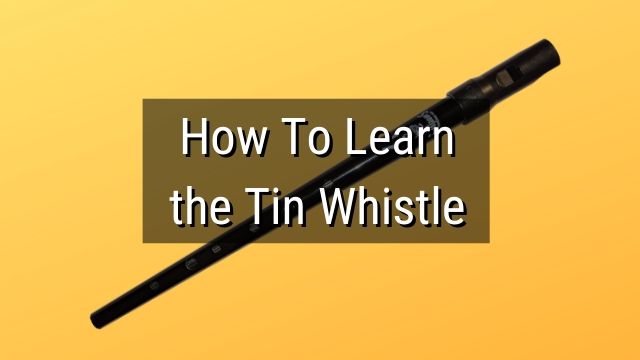
By the way, looking for recording equipment and musical instruments? Check out Sweetwater.com for microphones, monitors, audio interface or any other recording gear that you could ever need. (Affiliate Link)
An essential tin whistle learning plan is comprised of the following:
- Scales
- Music Theory (depending on your music experience)
- Learning new songs
- Memorization
- Technique and Ornamentation
- Listening to Traditional Tin Whistle Music
Now that’s easy to say those learning methods, but what do those really mean? I’ve spent the time for you to compile a learning plan that incorporates all that you need to know.
Getting Started
If you haven’t already, it’s time to choose a tin whistle. It does matter when choosing a tin whistle, especially since there are dozens of varieties and keys of tin whistles to choose from.
Choosing a Whistle
The tin whistle isn’t like other instruments where you have to spend a ton of money to get an instrument that is of decent enough quality to enjoy playing. Tin whistles are extremely inexpensive compared to other instruments.
Just starting out, I wouldn’t recommend getting a whistle for more than $20.
I imagine your jaw just dropped a little. Yes,you can get a beautiful sounding instrument for less than $20. The tin whistle is unique in that way.
The Most Common Key For Tin Whistles
Furthermore, there are many keys you can buy a tin whistle in. If you’re starting out I recommend getting a tin whistle in D. D whistles are the most common and will be compatible with any tin whistle song book.
The Best Tin Whistles for Beginners
The best kind of tin whistle for beginners is an inexpensive tin whistle. Fortunately, and unlike other types of instruments, you can get a beautiful sounding tin whistle for very, very little money, making this a fantastic starting instrument.
Two popular and beautiful sounding choices are:
- Clarke’s Sweetone Tin Whistle in D
- Waltons Mellow D
Is the Tin Whistle a Real Instrument?
You might be wondering if it’s worth learning the tin whistle if it’s just a toy instrument. I can assure you, that the tin whistle has incredible depth and beauty waiting for those who spend the time to learn it. Check out my article here if you want further discussion on whether the tin whistle is a real instrument.
Get a Song Book
There are two types of song books you can get:
- A structured learning songbook which teaches you the basics as well as introduces you to songs with a gradual increase of difficulty
- A songbook which is simply a compilation of songs. If you want to learn the possibilities of the tin whistle, I highly recommend a songbook with Irish tunes
Which of these two do you start with? Well, if you can, both are a good investment in improving your skill, but if you are choosing one I 100% recommend getting #1, a structured learning songbook.
Choosing a Structured Learning Songbook
The book I learned on was Clarke’s Tin Whistle Book by Bill Ochs. This book is a fantastic starting resource for many reasons:
- It contains basic music theory explanations. If you don’t know how to read music, this book will walk you through how to read what you need to learn the tin whistle.
- Songs of various origins demonstrating the capabilities of the tin whistle from very easy to very difficult
- Traditional Irish songs that are pivotal for learning tin whistle ornamentation
- A CD that goes along with the songs in the book–this is crucial for learning and understanding how the tin whistle can be played, particularly how traditional Irish music can be interpreted.
Which structured songbook you choose isn’t as important as long as it has the above attributes. Some well-known books are:
- Clarke’s Tin Whistle book by Bill Ochs
- Mel Bay’s Complete Irish Tin Whistle Book by Dona Gilliam
- How to Play the Penny Whistle by Gina Landor
- The Complete Irish Tin Whistle Tutor by L.E. McCollough
The Best Way to Practice the Tin Whistle
Now that you have a whistle and (hopefully) a structured songbook, you are now awesome!
Next, let’s learn how to actually play and then you’ll be more awesome.
To learn the tin whistle quickly and effectively, you have to incorporate a combination of different practices.
Practice Scales and Intervals
I know, you’re probably already rolling your eyes and remembering your middle-school band teacher telling you to practice scales, but your middle-school band teacher had a point!
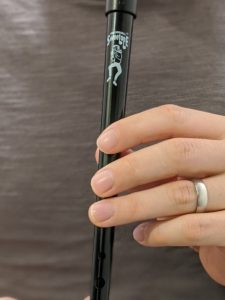
Why Scales and Intervals Can Jumpstart Your Learning
Especially since the tin whistle is a diatonic instrument (read our article here to see what that means), meaning it is only in one key, practicing scales and intervals helps you to play extremely common patterns in music. Because you only have one key (two keys actually, read on to learn more), you have fewer scales to memorize!
It’s a bit easier to understand if you think of it as if you were learning a language. You can think of scales and intervals like learning common phrases like: “How was your day today?” and “where’s the pizza?”. Scales and intervals make up the bits and pieces of any song you’ll play, therefore practicing them will accelerate your learning.
Furthermore, scales and intervals help you learn the fingerings.
A Quick Refresher On Scales
A scale is simply a list of notes following an interval pattern. When someone says a “Major scale” what they mean is a series of notes that are a particular distance apart. The tin whistle is a D Major instrument, and so I’ll share the interval pattern for any Major Scale along with the notes of the D Major scale.
| D | E | F# | G | A | B | C# | D |
| Start | Full step | Full step | Half step | Full step | Full step | Full step | Half step |
This is the same interval pattern for all major scales in every key.
How To Practice Scales
Practicing scales is simple, pick a slow enough pace where you can play each note regularly and without fumbling, starting from the bottom note in the scale, all the way to the top. Then, start from the top, and then go back to the bottom. A common pattern to work towards is a quarter note for the 1st note, and then eighth notes for the notes in between till you get to the top.
Here is the fingering for the D scale on a D tin whistle, going up and down:
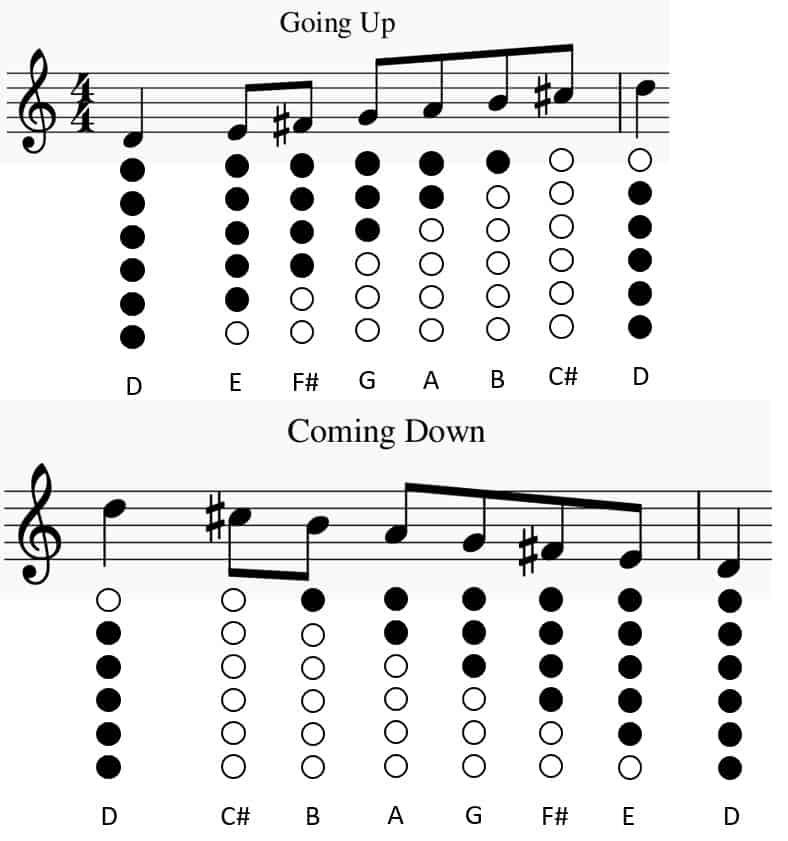
Now one cool thing is that the tin whistle has an easy fingering that allows you to play C instead of C#, this opens up another scale, the G major scale:
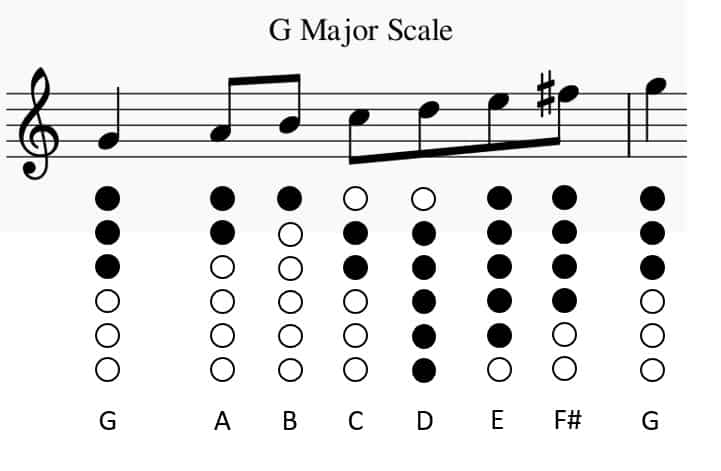
Lastly, it’s important to practice the full range of the instrument. Although the tin whistle can go higher, I am only putting the first two octaves, since above that you need earplugs to practice (not kidding).
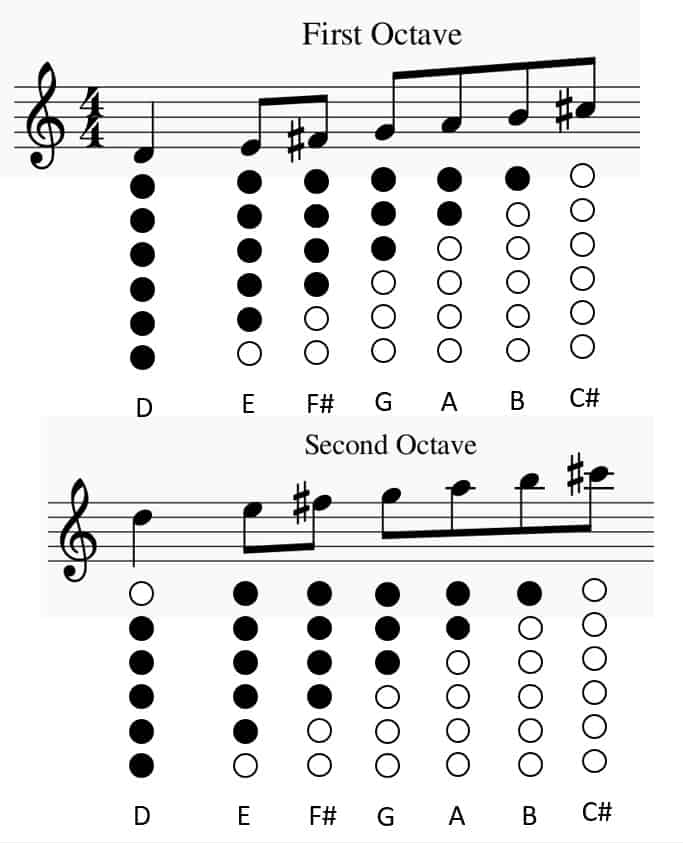
Secret Ninja Music Theory Tips
What’s also important to know about the tin whistle is that no matter what key of tin whistle you buy, the fingerings are the same. So if you buy a C whistle, the scale fingerings will look exactly the same even though the notes will be a whole step lower.
Random tidbit: the tin whistle is a transposing instrument which means that the sheet music for the tin whistle will always be the same no matter what key you get (many concert instruments fall in this category). If you wanted to convert the notes to match the notes on the piano, you will have to transpose.
What Are Intervals?
If you were ever in band or if you had a piano teacher, you’ve likely had to practice intervals. Often music books will have the major interval right after a major scale.
So, if a D Major scale looks like these notes:
| D | E | F# | G | A | B | C# | D |
Then the D Major interval would be the 1st, 3rd, and 5th notes. To make it sound pretty you can throw in the next octave of the starting note:
Example of a D Major interval:
| D | E | G | D |
Now the G major scale interval:
| G | B | D | G |
How To Practice Intervals
Similar to scales, you go up the notes of the interval in a steady rhythm and go back down again.
Here are the fingerings for the D Major scale interval:
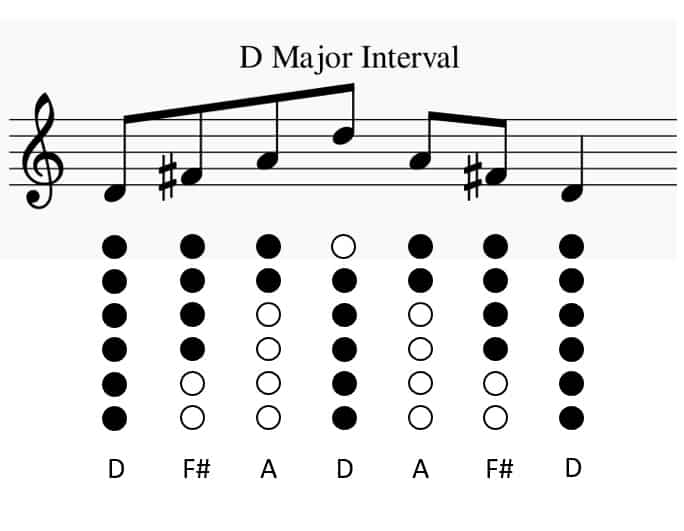
Here are the fingerings for the G major scale interval:
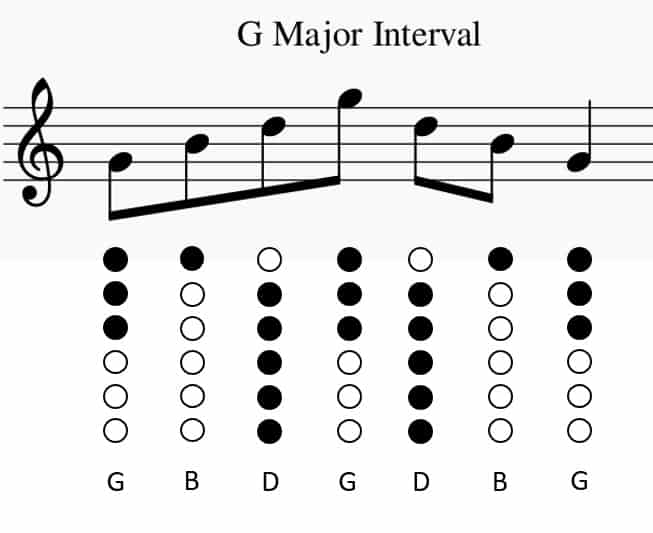
Taking Scales and Intervals To the Next Level
Cool, that’s it right? You’re done?
No… you’ve just started. It’s really good to get the two major scale intervals and scales figured out, since much of the music you will play will be in those keys.
However, the fun continues! One of the most exciting things I learned about the tin whistle is an incredibly powerful music theory principle: depending on what note you start in a major scale gives you a different scale altogether!
In music theory they give these modes fancy names:
| Position in Scale | Starting Note for D Major | Mode |
| 1 | D | Ionian |
| 2 | E | Dorian |
| 3 | F# | Phrygian |
| 4 | G | Lydian |
| 5 | A | Myxolydian |
| 6 | B | Aeolian |
| 7 | C# | Locrian |
What’s super cool about this is that all of these modes have completely different feels! Also, you don’t have to insert any new notes! You are essentially playing the D Major Scale with a different starting position.
Which Modes To Practice
Although all modes will be valuable, Learn the D and G Major scales and intervals first (Ionian), then learn the Aeolian scales and intervals, followed by Myxolydian, and then Dorian, followed by Phrygian.
Another name for the Aeolian mode is the melodic minor. So much of the music we play is in a minor key. I tried to organize the modes to learn by how frequently a song is in that mode.
Learn New Songs: Keep It Fun
Wow, there is so much to learn about scales and keys and music theory! You technically don’t have to know any theory to learn any instrument, but I have definitely found that it helped my learning process as I picked up the tin whistle. Everybody learns differently–but I do encourage you to spend the time learning theory if you aren’t familiar with music.
However, you are practicing your instrument so you can play songs, not scales, and learning songs is an important part of your practice.
Use your songbook! Carefully go through each song. Try to practice your song to the point where you don’t make mistakes before moving on to the next song. Make sure you listen to the song if you can so you can get a feel for the song. This is extremely important if you’re learning the tin whistle.
Folk songs that feature the tin whistle, such as Irish and Scottish folk music have much different interpretations of rhythm than what you might be used to. For example, in Irish folk music, many songs interpret eighth notes and triplets don’t play them exactly as you would in modern music.
There’s a slight hold on the first note of a triplet in a lot of folk styles. Listen to someone play the song who understands these rhythm interpretations so you can play the right rhythm from the get go.
Memorize
If you’re trying to practice tunes over and over again until you get them right, you’ll find that you’ll be halfway to memorizing them!
Challenge yourself and memorize your favorite pieces. Memorization is a different skill, and it’s an essential skill if you’re serious about the tin whistle. In an Irish Session, the songs are played so rapidly that advanced groups don’t use any sheet music at all, but rather, expect all songs to be memorized.
Tin Whistle Technique and Ornamentation
Tin whistles are amazingly dynamic instruments, and in order to really take this instrument to the next level, it’s essential to learn and understand tin whistle technique and ornamentation.
There are many techniques that apply to other instruments that are necessary to learn the tin whistle, such as slurring, tonguing (in certain styles of music), glissandos, etc. However, tin whistle has a set of techniques that are particular to the tin whistle called ornamentations. Although many instruments have ornamentations as well, tin whistle ornamentations are more than simple frills, they are a crucial part of Irish music.
Some argue that a beginner shouldn’t touch ornamentation. I spent a month learning the tin whistle for an hour every day as an absolute beginner. I can say that I wish that I had practiced ornamentation just a little bit from the beginning. Even if you aren’t incorporating it into your music as you are starting to learn to play (which I agree that you shouldn’t), it’s important to know what sound you will be heading towards.
Don’t jump the gun and try to learn ornamentation first because it’s important the basics first, but be aware of them. Make it a small part of your practice, with the majority of your practice being learning breath control, the fingerings, and basic technique.
If you want to learn more about tin whistle ornamentation as well as tin whistle technique, I made a post about this subject, here.
Listen to Songs With the Tin Whistle
Lastly, this is an important principle that can’t be understated. The Irish tin whistle has a sound and interpretation that is likely to be very different than the music you typically listen to. It’s important to get the feel of the music. What happens when you pick up an instrument and try to play a reel that you haven’t played before? If you don’t know how it should sound, then it’s time to keep listening so you can absorb the feel of the music.
It’s good to listen to music with tin whistle in it, and I’d say your focus can be there.
Let’s try listening to a short song and see what we can learn:
These are two reels–which have the characteristic of being moderate tempo with lots of energy.
As you listen to this song you’ll notice a few things:
- There is no tonguing! The entire song is slurred and only separated by tin whistle ornamentation. You can hear cuts, strikes, and rolls very prominently throughout the song. These give the same separation that tonguing would, and therefore tonguing is rarely heard in traditional Irish music.
- Besides his foot tapping, you can hear a clear accent of the beat in the music. You’d be able to feel the beat even without his foot tapping.
- The player uses his breath as a way to provide an accent and a break in the music–it’s done seamlessly
There’s a mountain of wisdom you can see in this one song. Listening will help you understand the music as you play.
Irish Sessions
Irish Sessions are the ultimate jam sessions (in my mind)–players of equal playing capabilities meet at a pub in cramped quarters and go through songs at speeds that I can’t even imagine.
You can find many sessions on YouTube and they are phenomenal examples of traditional Irish music and the experience of a session:
Learning Schedule For Music Beginners
If you’re ready to get started! Here’s a learning schedule you can follow if you’re a beginner to music and a beginner to the tin whistle. I’m going to assume you only have half an hour a day to practice, but if you have an hour, you can double these time increments.
| Study Skill | Time Per Day |
| Scales and Intervals | 5 minutes |
| Songs from your Songbook (this covers technique, song learning and memorization) | 15 minutes |
| Music Theory (YouTube and Google “Music Theory for Beginners”) | 5 minutes |
| Ornamentation (don’t do too much of this. Just familiarize yourself until you’re ready–this could take months of daily practice) | 5 minutes |
Ways to Adapt the Beginner Learning Schedule
Learning music theory is a lifelong journey, but you really only need to understand the context of your instrument. Learning the different scales and modes and what they mean is essential. Past that, learning chord progressions and how music is structured is very helpful as well. If there’s nothing in your songbooks that surprises you, then it may be time to focus on something else.
You can substitute free play for learning music theory if you already know it. It’s good to learn songs, but it’s also good to explore the instrument on your own without any structure. Play songs you know and love, or simply improvise.
